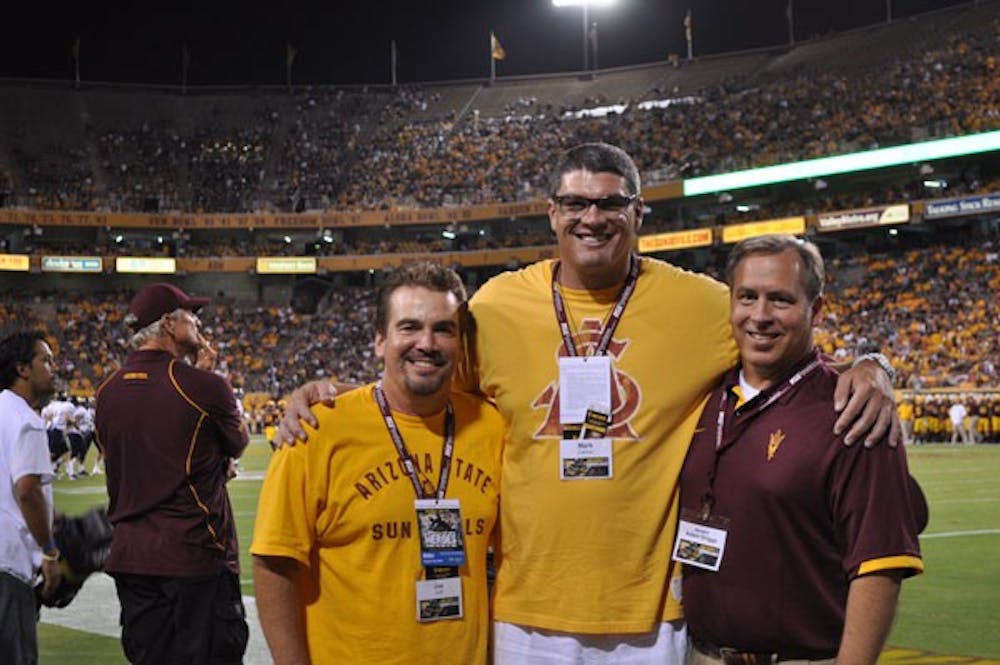 The creators of the pitchfork hand sign, Joe Cuff (left), Mark Carlino and Adam Driggs pose on the field during the ASU football game against NAU on Aug. 30.
The creators of the pitchfork hand sign, Joe Cuff (left), Mark Carlino and Adam Driggs pose on the field during the ASU football game against NAU on Aug. 30.(Photo courtesy of Adam Driggs)
The “Gator Chomp.” The “Hook ‘em Horns.” The “Tomahawk Chop.” The “Horned Frog.”
All of the popular college hand signals representing their respective mascot or chant have some place of origin and a story behind them.
These hand signals didn’t just come with their university’s establishment.
At some point in those schools’ history, a student, athlete or icon created a gesture that would forever change the student body and university.
In 1986, three students — one of them attended Brigham Young — would stick a fork in ASU’s history.
“We came up with the idea while we were in San Diego in July of 1986,” Adam Driggs said, then a BYU student. “We were on the beach talking about how great the Sun Devils were going to be that year and that we needed to do something that would be symbolic of ASU football.”
“We thought we could do something like Texas’ ‘Hook ‘em Horns’ or Florida State’s ‘Tomahawk.’”
The other two that worked with Driggs were ASU students Joe Cuff and Mark Carlino, all of who were friends since grade school.
Driggs, despite attending BYU, grew up in Arizona and became an ASU fan. He later received his law degree from ASU in 1993.
“Even then, I was a Sun Devil more than (I was) a Cougar,” Driggs said.
Cuff was going into his senior year as a broadcast major at what is now the Walter Cronkite School of Journalism and Mass Communication.
Carlino was going into his junior year as a business-finance major in the W.P. Carey School of Business.
According to them, Cuff suggested the idea of coming up with a hand sign, while Driggs and Carlino perfected it.
“I originally came up with the idea of making a pitchfork sign by holding up three fingers and holding down my pinky with my thumb,” Driggs said. “We all liked the idea but thought it looked like we were (signaling) No. 3.”
Possibly the most historical idea in ASU and Sun Devil sports history then came to light.
“Then Mark had the idea of holding down the ring finger with the thumb, and we all thought that would work better,” Driggs said.
Right they were.
The discovered pitchfork hand signal wasn’t just spread around campus by word of mouth.
Carlino — then a part of the ASU men’s basketball team — showed their new creation to the cheerleaders who made the sign in front of the student section at football games.
“Without a doubt, it wouldn’t have spread as quickly if the cheerleaders didn’t help,” Driggs said.
The pitchfork spread like wildfire all over campus and throughout the crowd at football games.
From then on, ASU became nationally recognized by the three-fingered pitchfork.
Images of President George W. Bush flashing the pitchfork and professional athletes like Phil Mickelson, to this day, throw up the pitchfork from time to time.
There’s some question whether or not the three fans truly were the ones who invented the hand pitchfork.
They all seem to have the same response.
“Many people have doubted the fact we started it, but we know the truth, so I would always just smile when someone questions it,” Cuff said.
Back in 2004, The Arizona Republic’s Paul Coro wrote an article on the three pitchfork creators and confirmed their claim.
They went through old ASU archive photos of past ASU athletic events for any sign of a “pitchfork” signal.
Nothing was found prior to 1986, but photos were found post-1986 of players and fans throwing up the pitchfork.
“It is the best sign in college sports,” Driggs said. “When I raise my hand to make the pitchfork sign, I don’t think about it too often. It’s pretty cool when I do think about it.”
It’s amazing how something so small can transform into something that transforms a program and a university.
That is the pitchfork story.
Reach the columnist at msterrel@asu.edu




